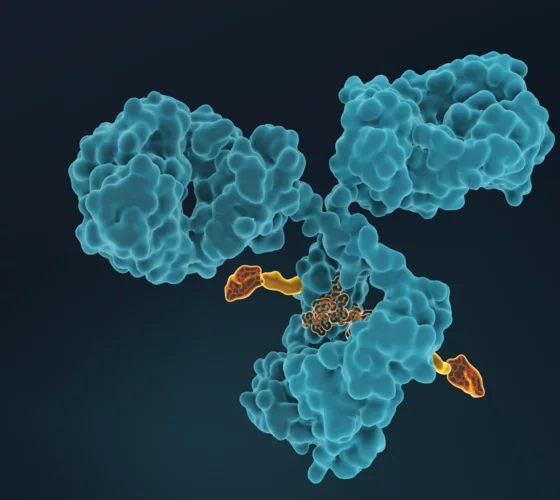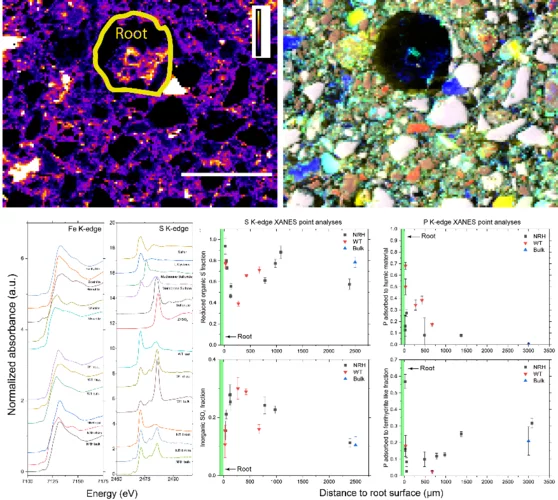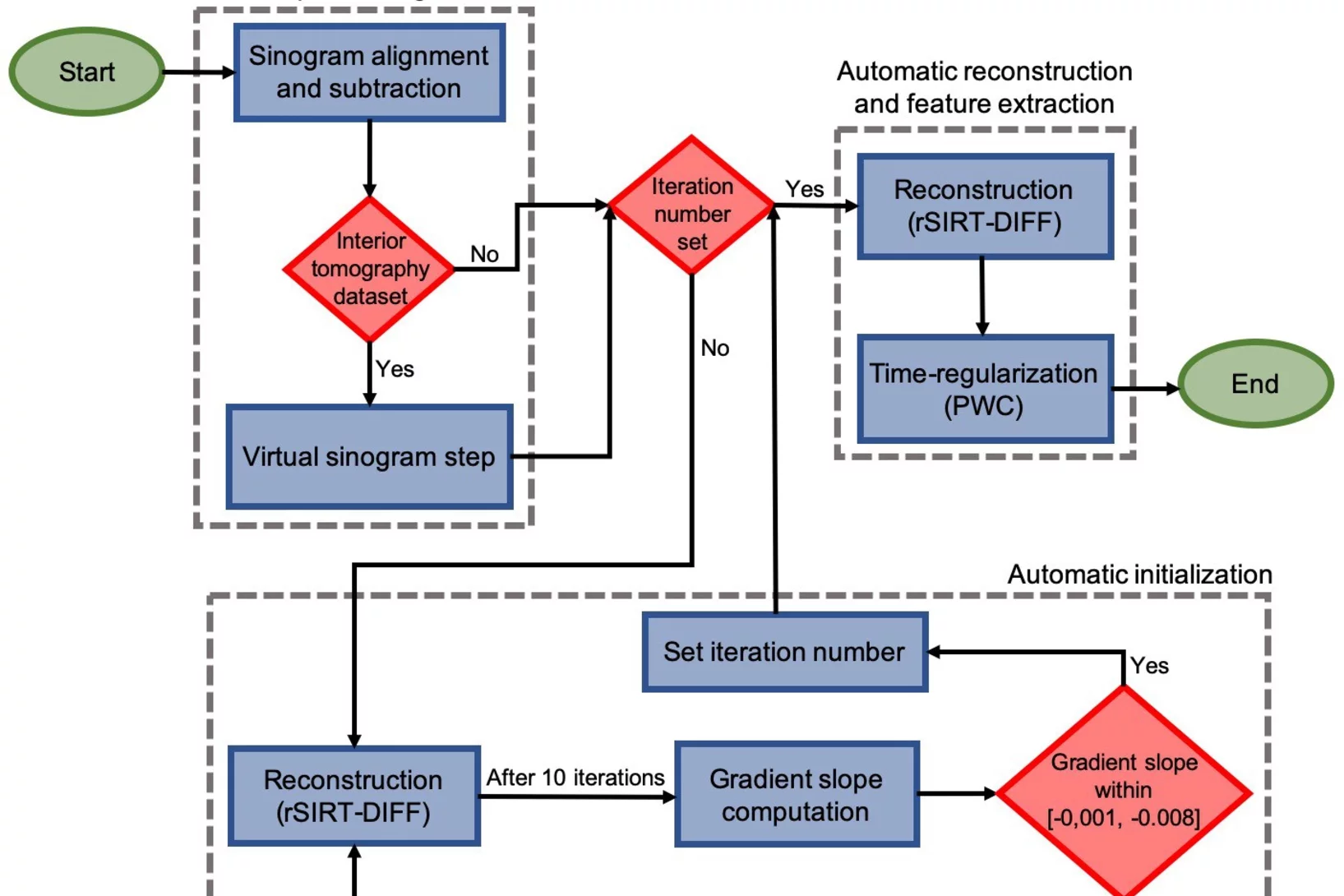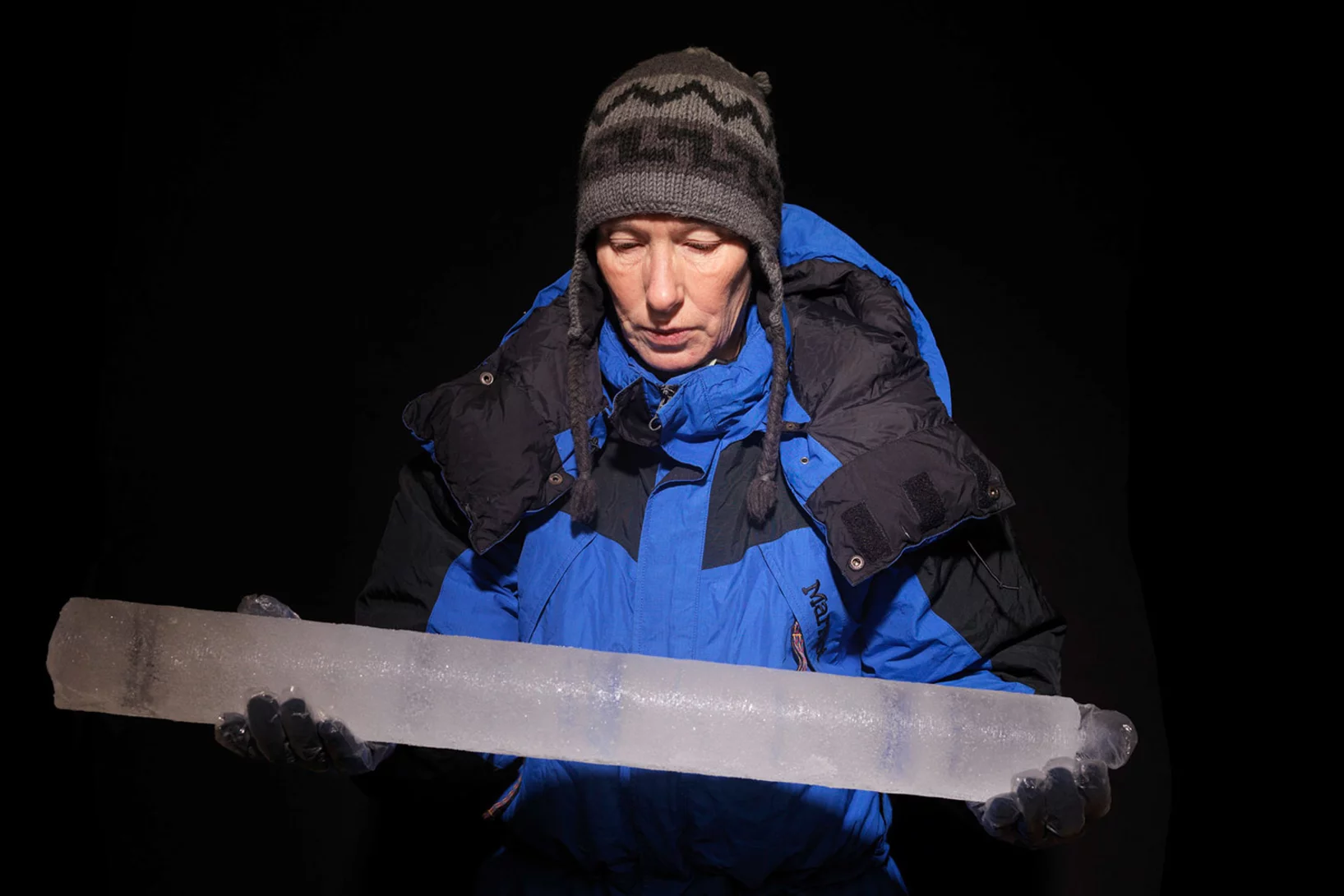At PSI, several projects are dedicated to important research questions concerning the Sars-CoV-2 coronavirus and the resulting diseases. We provide information on activities and projects, for example on investigations of lung tissue, on the production of proteins and antibodies or on ideas for new research on Covid-19.
Useful links
Phosphorus recovery from wastewater: Nitrogen K-edge micro-XANES spectroscopy unravels the effects of nitrification inhibitor on fertilizer phosphorus uptake of maize
Phosphorous containing fertilizers are essential to feed the growing population on earth. Because phosphorus (P) is a scarce resource in the European Union, recovering P from wastewater and sewage sludge has become extremely important. However, the availability of P to the plant is limited in such recycling P fertilizers. To overcome this problem, co-fertilization with nitrogen (N) in the form of ammonium and nitrification inhibitors, is a promising pathway. By applying the novel N K-edge micro-XRF and micro-XANES methods at the PHOENIX beamline on the soils, we could verify that a nitrification inhibitor indeed promotes ammonium fixation in fertilized soils, and hence causing a slow-release of temporarily fixed ammonium. This deceases local pH, making P better available to plants.
Uncovering the short range order and local distortions in high entropy alloys using EXAFS
High entropy alloys (HEA), medium entropy alloys and multi-phase compositionally complex alloys (CCA) have gained much attention in the last 20 years because of their outstanding mechanical properties. Such baseless alloys provide different open questions on local chemical ordering, lattice distortions, orbital hybridization and/or charge transfer which define the very nature of alloys’ mechanical properties. By combining EXAFS measurements in the rarely served tender x-ray range (PHOENIX-SLS, Al K-edge) and at higher X-ray energies (BM08-ESRF, transition metal K-edges), local chemical ordering in a CCA, Al8Cr17Co17Cu8Fe17Ni33 was quantified showing preferred Al-Ni and Al-Cu pairs. In addition, slight structural distortions, much lower than the predicted ones of metallic radii, were found.
4 Lernende an den Schweizermeisterschaften
Die PSI-Elektroniker EFZ sind unter Strom
From magnetic order to quantum disorder in the Zn-barlowite series of S = 1/2 kagomé antiferromagnets
We report a comprehensive muon spectroscopy study of the Zn-barlowite series of S=1/2 kagomé antiferromagnets, ZnxCu4−x(OH)6FBr, for x = 0.00 to 0.99(1). By combining muon spin relaxation and rotation measurements with state-of-the-art density-functional theory muon-site calculations, we observe the formation of both μ–F and μ–OH complexes in Zn-barlowite. From these stopping sites, implanted muon spins reveal the suppression of long-range magnetic order into a possible quantum spin liquid state upon the increasing concentration of Zn-substitution.
SwissFEL: a perfect habitat for the black mortar bee
For the construction of the SwissFEL facility in 2013, around five hectares of forest were cleared and transformed into a new habitat for flora and fauna. Biologists and forest engineers have now assessed the results of the renaturization project and are excited about the progress to date.
Araris Biotech successfully closes CHF 15.2 Mio seed round
Araris, one of PSIs youngest spin-offs, today announced that they have successfully closed a CHF 15.2M seed round with a group of previous and new investors. The funds raised will allow the further development of the ADC linker technology licensed out by PSI and hopefully identify potent drug candidates.
Dr. Philipp Spycher, CEO of Araris Biotech AG began his entrepreneurial endeavors with the PSI Founder Fellowship that helped kick-start his ideas of building a business around the technology that he helped to develop at PSI.
PSI applauds this development and looks forward to a bright future for Araris.
Front passivation of Cu(In,Ga)Se2 solar cells using Al2O3: Culprits and benefits
In the past years, the strategies used to break the Cu(In,Ga)Se2 (CIGS) light to power conversion effi- ciency world record value were based on improvements of the absorber optoelectronic and crystalline properties, mainly using complex post-deposition treatments. To reach even higher efficiency values, fur- ther advances in the solar cell architecture are needed, in particular, with respect to the CIGS interfaces. In this study, we evaluate the structural, morphological and optoelectronic impact of an Al2O3 layer as a potential front passivation layer on the CIGS properties, as well as an Al2O3 tunneling layer between CIGS and CdS.
Sodium-ion batteries: a study of the structural and electrochemical properties of the layered cathode material NaxMnyO2
Being able to replace Lithium by the much more abundant sodium for new batteries would be an important asset for energy storage. For example, NaxMnyO2 cathodes would offer a high initial specific charge and a relatively high working potential. Despite long, intensive research of the electrochemical properties of these materials, the open key question remains unresolved: Where does the sodium goes to in the charging /discharging process. Unfortunately, the (de)sodiation mechanism in those materials was not completely understood, especially in terms of types of phases in which Na stays during cycling, which in turn impeded the optimization of its performance. Using the unique tender energy range of the PHOENIX beamline, we used Na K-edge X-ray absorption spectra measurements to gain a better understanding about the Na atomic positions in phases appearing during cycling. Thanks to this unique method, we established that observed high capacity in NaxMnyO2 is due to the high-voltage phase being an intergrowth structure between P2 and O2 type phases were Na ions stays both in tetrahedral and octahedral sites.
Wait and see, and grow crystals
At PSI, researchers decipher the structure of the proteins in bacteria and viruses. This knowledge can aid, for example, in the development of drugs against infectious diseases. But before the investigation can begin, an extremely tricky problem has to be solved: the crystallisation of the molecules.
Lithium-ion batteries: following the redox reaction of oxygen and transition metals in the Li1.2Mn0.6Ni0.1Co0.1O2 electrode using X-ray absorption spectroscopy
The new generation of cathode materials from the Li-rich NMC (nickel-manganese-cobalt) group are under constant investigation due to their extremely high energy densities resulting from redox reactions involving both transition metals and lattice oxygen. Although a lot of research has been done so far, the exact mechanism of lithium (de)insertion in those materials, especially the reactions involving redox reactions of lattice oxygen is still elusive. Due to the particular battery design the observed reactions starts at the surface of the electrode that contacts the electrolyte and, as the reaction continues, goes deeper into the bulk structure. In order to follow the reactions taking place in the Li-rich NMC materials we aimed to exactly distinguish and characterize the phase transitions taking place on the surface and within the bulk of the Li1.2Mn0.6Ni0.1Co0.1O2 electrode. To do so we used comprehensive XAS measurements at the PHOENIX beamline, taking advantage of the unique options to perform in situ experiments in the soft energy range to study both the Oxygen K edge and the L edges of Ni, Co and Mn.
Enhanced Stability of a Pyrophosphate cathode for Na-ion batteries
The structural changes of Na3.32Fe2.11Ca0.23(P2O7)2 during several charge discharge cycles is viewed by its powder pattern and selected cell parameter evolution.
Harnessing components from the optical internet for programmable spectroscopy
A novel concept for extracting information from spectra where traditional post-processing procedures fail, dubbed ‘software-defined spectroscopy’, offers a fresh approach to high-resolution terahertz spectroscopy. The new method implements an ‘optical comb’ and combines it with a programmable modulator, all using components from the optical internet.
Dr. Manuel Guizar-Sicairos elected as Fellow member of The Optical Society (OSA)
Dr. Manuel Guizar-Sicairos, beamline scientist at the cSAXS beamline, was elected as a Fellow Member of The Optical Society (OSA) for seminal contributions to methods and applications of coherent lensless imaging, ptychography, x-ray nanotomography, and new modalities of x-ray microscopy.
Root induced soil deformation influences Fe, S and P: rhizosphere chemistry investigated using synchrotron XRF and XANES
Taking up nutrients from the soil is key to plant growth. Understanding and potentially controlling this process is important when growing food but also when caring for natural habitats, which are the basis for life on Earth. Typically, nutrients are tightly chemically bound to the soil, and roots need to create a chemical environment to harvest nutrients. Here we use the special capabilities X-ray microscopy with tender X-rays to study the chemical changes of sulfur, phosphorus, and iron in the vicinity of plant roots (rhizosphere). We can show that Fe is slightly reduced, S is increasingly transformed into sulfate (SO42−) and phosphorus (P) is increasingly adsorbed to humic substances in this enrichment zone around the root.
Demonstration of Muon-Beam Transverse Phase-Space Compression
We demonstrate efficient transverse compression of a 12.5 MeV=c muon beam stopped in a helium gas target featuring a vertical density gradient and crossed electric and magnetic fields. The muon stop distribution extending vertically over 14 mm was reduced to a 0.25 mm size (rms) within 3.5 μs. The simulation including cross sections ...
A protein's unexpected "doming"
Researchers have coaxed a secret out of the vital protein cytochrome c that it kept well-hidden up to now. Measurements at the X-ray free-electron laser SwissFEL reveal structural changes that science had previously ruled out for this kind of biomolecule.
Refined diagnosis of the “concrete disease”
When bridges, dam walls and other structures made of concrete (cement and aggregates such as sand/gravel) are marked by map-like cracks after a few decades, the diagnosis is ASR (alkali-silica Reaction), in popular science terms also called “concrete disease or concrete cancer”. The ASR-induced microscale crack initiation can hardly be modelled, mainly due to our limited knowledge of the structure and property of the ASR products. Using X-ray absorption micro-spectroscopy at the PHOENIX beamline of the Swiss Light Source (SLS) allowed a refined diagnosis of ASR products by providing new insights into the crystallinity and structure of ASR products with micro-scale resolution.
Installation of Heidelberg DWL66+
Heidelberg DWL66+ direct laser writer, funded by ANAXAM, is in operation now. It is a new photolithographic system closing the gap between the mask aligners on one side and the Nanoscribe two-photon 3D lithography system on the other. It is equipped with semiconductor laser with the wave length of 405 nm and is capable of exposing the minimum feature size down to 0.3 µm on wafers up to 200 mm or 9"x9" mask blanks.
Measurements at PSI enabled detailed understanding of genetic scissors
PSI congratulates Emmanuelle Charpentier and Jennifer Doudna on winning this year's Nobel Prize in Chemistry. Experiments at the Swiss Light Source SLS in 2013 made it possible to elucidate the structure of the protein complex CRISPR-Cas9.
Improved Interfacial Stability of Ni-rich Oxide Full-Cells
PSI researchers have identified a novel electrolyte additive, allowing extended voltage range of Ni-rich oxide full-cells, while keeping excellent performance. The instability of cathode–electrolyte interface causes the structural degradation of cathode active material and the electrolyte consumption, resulting in a rapid capacity fading and shortening battery life-time. The PSI-identified additive help to alleviate these problems and extend battery life-time.
Electroless Deposition of Ni–Fe Alloys on Scaffolds for 3D Nanomagnetism
3D magnetic nanostructures are of great interest due to the possibility to design novel properties and the benefits for both technological applications such as high-density data storage, as well as more fundamental studies.
One of the main challenges facing the realization of these three-dimensional systems is their fabrication, which includes the deposition of magnetic materials on 3D surfaces. In this work, the electroless deposition of Ni–Fe
on a 3D-printed, non-conductive microstructure is presented.
Technology Briefing: Smart Energy Applied Solutions
Wednesday, November 11, 2020, from 13:30 to 18:00
Empa, Überlandstrasse 129, 8600 Dübendorf (Participation possible on site OR via Zoom)
Online registration: www.empa-akademie.ch/technology
The conference series aims at informing our industry and business partners about pressing issues of practical relevance. Speakers representing CSEM, Empa, PSI and industry will cover a well-balanced and practice-oriented overview of the latest technologies. The event also provides a platform for knowledge sharing and exchange of experiences, allowing the identification of potential cooperation and further innovation.
More effective treatment of thyroid cancer
PSI researchers have found a more effective treatment for a form of thyroid cancer – and with fewer side effects – by increasing the uptake of the cancer drug in tumour cells. The results have been published in the medical journal Theranostics.
Automatic extraction of dynamic features from sub-second tomographic microscopy data
A fully automatized iterative reconstruction pipeline designed to reconstruct and segment dynamic processes within a static matrix has been developed at TOMCAT. The algorithm performance is demonstrated on dynamic fuel cell data where it enabled automatic extraction of liquid water dynamics from sub-second tomographic microscopy data. The work is published in Scientific Reports on 2 October 2020.
Automatic extraction of dynamic features from sub-second tomographic microscopy data
A fully automatized iterative reconstruction pipeline designed to reconstruct and segment dynamic processes within a static matrix has been developed at TOMCAT. The algorithm performance is demonstrated on dynamic fuel cell data where it enabled automatic extraction of liquid water dynamics from sub-second tomographic microscopy data. The work is published in Scientific Reports on 2 October 2020.
Iodic acid influences cloud formation at the North Pole
An international team of scientists has identified a novel driver of new aerosol particle formation in the Arctic: iodic acid, a chemical compound, which had not previously been observed in the region.
"We were shocked how far advanced the melting is already"
An international expedition with the participation of the Paul Scherrer Institute PSI discovers advanced glacial melting at an elevation of more than 4,000 metres on the Grand Combin in Valais. In the Alps, it may almost be too late for the Ice Memory project, which aims to save ice cores as a climate archive for future generations of researchers.
Swiss National Science Foundation Ambizione grant for Franziska Hagelstein
Franziska Hagelstein has been awarded a Swiss National Science Foundation Ambizione grant with PSI as host institution. She joined the particle theory group (NUM, Laboratory of Particle Physics LTP) in October 2020. In the near future she will be accompanied by a PhD student.
Mites in the spotlight
The world of microbes and viruses is extremely old and exceedingly diverse. With the large research facilities at PSI, researchers are peering deep inside this alien cosmos and investigating, above all, the proteins of these exotic beings.
Two-color snapshots of ultrafast charge and spin dynamics
In a joint research effort, an international team of scientists lead by Emmanuelle Jal (Sorbonne Université) performed a time-resolved experiment at the FERMI free-electron laser to disclose the dynamic behavior of two magnetic element of a compount material in only one snapshot. The X-ray Optics and Applications group developed a dedicated optical element for this experiment that is usable with two different photon energies (colors) simultaneously.





























